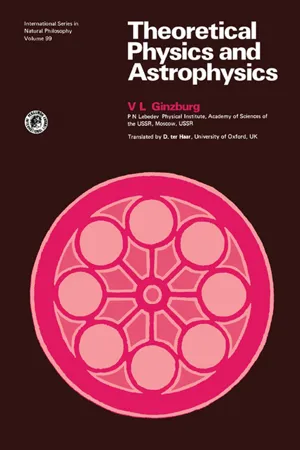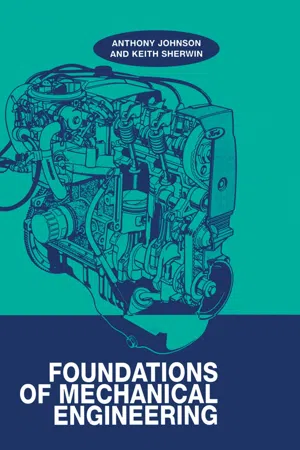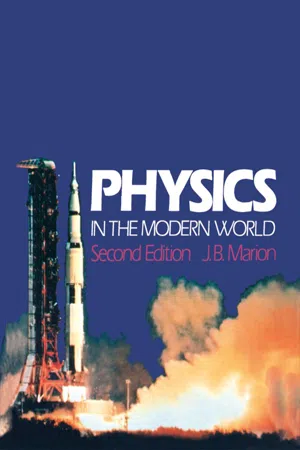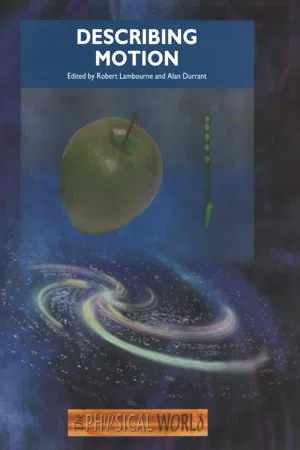Physics
Uniformly Accelerated Motion
Uniformly Accelerated Motion refers to the motion of an object with a constant acceleration. In this type of motion, the velocity of the object changes by the same amount in equal time intervals. This results in a linear increase or decrease in velocity over time, leading to a parabolic path for the object's motion.
Written by Perlego with AI-assistance
Related key terms
7 Key excerpts on "Uniformly Accelerated Motion"
- eBook - ePub
- V.L. Ginzburg, D. ter Haar, D. ter Haar(Authors)
- 2013(Publication Date)
- Pergamon(Publisher)
A motion in which the acceleration is constant in the comoving (eigen) frame of reference, that is, in the frame in which the particle velocity is zero, is called a relativistic Uniformly Accelerated Motion. This means that for a Uniformly Accelerated Motion in the comoving frame, and just in that frame, we have always. In covariant form this condition can be written in the form d w i d s + α u i = 0,, where α is a constant; when v = 0, the condition written down here indeed changes to the equation. Bearing in mind that u i u i = 1 and w i u i. ≡ (du i /ds)u i = 0, we find that α = − d w i d s u i = w i w i. We are thus led to the condition which defines the Uniformly Accelerated Motion d w i d s + w k w k u i = 0 ; (3.8a) (3.8a) This condition has the following form in three-dimensional notation: (1 − v 2 c 2) v ¨ + 3 c 2 (v · v ˙) v ˙ = 0. (3.8b) (3.8b) When we multiply (3.8a) by w i we see that for a uniformly accelerated. motion w i w i = − w 2 c 4 = c o n s t a n t, (3.9) (3.9) where w is the acceleration in a frame of reference in which the particle is at rest (see also (3.7)). The reverse statement is, however, incorrect: in the general case the fact that w i w i is constant does not yet guarantee that conditions (3.8a) or (3.8b) are satisfied, while these conditions must be satisfied if we take the definition of a Uniformly Accelerated Motion which was given earlier; our definition is an obvious one, but if one so wishes one might call a motion with a constant square of the four-dimensional acceleration, that is, one which satisfies condition (3.9), Uniformly Accelerated Motion. We note that when a charged particle moves in a constant and uniform electromagnetic field and if we neglect the radiation reaction condition (3.9) is immediately satisfied. Indeed, differentiating the equation of motion (for a definition of F ik see Landau and Lifshitz, 1975) d u i d s ≡ w i = e m c 2 F i k u k, with respect to s, we see - eBook - ePub
- A. D. Johnson(Author)
- 2017(Publication Date)
- CRC Press(Publisher)
The motion can be expressed graphically as shown in Figure 2.5. Fig. 2.5 Uniform acceleration shown on a velocity–time graph. Referring to Figure 2.5, the following observations can be made: change of velocity = v 2 − v 1 This change of velocity can be related to the acceleration because acceleration = a = rate of change of velocity = changeofvelocity timetaken = v 2 − v 1 t and transposing gives v 2 = v 1 + a t (2.2) This equation can be compared directly with the diagram in Figure 2.5. Figure 2.5 shows that the velocity increases at a uniform rate between v 1 and v 2. The average velocity can therefore be described as v ¯ = (v 1 + v 2) 2 and if s is the distance travelled during that period, equation (2.1) may be used in the form s = v t = average velocity × time In other words s = v ¯ × t and s = (v 1 + v 2) t 2 (2.3) From equation (2.2), it is possible to substitute for υ 2 in equation (2.3) : s = (v 1 + v 1 + a t) t 2 and rearranging. gives s = v 1 t + 1 2 a t 2 (2.4) The above equations are adequate for most purposes but there often arise situations where time t is the unknown. Since equations (2.2), 2.3 and (2.4) all possess t an expression is now needed for v 2 in terms of v 1, a and s, which excludes t. This is done by squaring both sides of equation (2.2) and substituting for s from equation (2.4). From equation (2.2) v 2 = v 1 + a t and squaring gives v 2 2 = (v 1 + a t) 2 so that v 2 2 = v 1 2 + 2 v 1 a t + a 2 t 2 or v 2 2 = v 1 2 + 2 a (v 1 t + 1 2 a t 2) But (v 1 t + 1 2 a t 2) is equal to s from equation. (2.4) : v 2 2 = v 1 2 + 2 a s (2.5) The equations (2.2), 2.3, 2.4 and (2.5), derived above, form the basis of all motion studies at this level and can easily be manipulated to cope with a range of situations, including falling bodies and rotary motion, as explained later. Example 2.3 A train has a uniform acceleration of 0.2 m/s 2 along a straight track - David V. Guerra(Author)
- 2023(Publication Date)
- CRC Press(Publisher)
(7.3)The SI unit for acceleration is (m/s)/s, which is usually written m/s2 .For example, as shown in Figure 7.5 , if a car is traveling northward at 10 m/s and speeds up to 30 m/s northward in 5 seconds, the average acceleration during those 5 seconds is:= ( 30 m/s northward – 10 m/s northward ) / ( 5 seconds ) = 4a ⇀Avg01m/s 2northward .FIGURE 7.5 Example of constant acceleration.If, during the 5 seconds in which the car is speeding up, the car increases its speed (without changing the direction of its velocity) at a constant rate, the acceleration is said to be constant and the acceleration at any instant in time during those 5 seconds will be the same as the average acceleration.When a rigid body undergoes purely translational motion, every part of the body undergoes the same motion, but different parts move along different curves or lines. When studying the motion of a rigid body, to determine the motion of the object, it is common to track the motion of the rigid body’s center of mass.7.2.1 One-Dimensional Motion
For this and the next few chapters, the motion studied will be along a line in one-dimension. It is common to choose our x-y-z coordinate system so that the x-axis or y-axis is along the line in which the motion occurs. Then, the motion will only have one component of displacementvelocityd ⇀,and accelerationv ⇀,a ⇀, such as the x-components, dx , vx, ax , or the y-components, dy , vy, ay- eBook - ePub
- Jerry Marion(Author)
- 2012(Publication Date)
- Academic Press(Publisher)
2MOTION
Publisher Summary
This chapter presents an overview of motion. It describes the motion of automobiles and planets. Acceleration is the change in speed per unit time. The speed of an object at any instant is equal to the slope of the distance–time graph. The acceleration of an object is equal to the slope of the speed–time graph. The chapter illustrates the connection between speed and acceleration. It further illustrates equations for the analysis of motion. When an object is dropped, the gravitational attraction of the earth causes the object to fall with continually increasing speed—the object is accelerated by gravity. The chapter discusses the vertical motion of an object moving freely near the surface of the earth. The vertical and horizontal motions do not affect one another. The chapter explains motion in two dimensions and discusses parabolic motion of an object.We live in a restless Universe. Everything around us—from the atoms that make up all matter to automobiles and aircraft to the distant galaxies of stars in space—undergoes motion. Every physical process involves motion of some sort. Because motion is such an important feature of every physical process, it is the logical subject with which to begin our detailed study of physical phenomena. The ideas developed here are used throughout this survey—in describing the motion of automobiles and planets, in discussing electric current, and in studying the behavior of atoms and nuclear particles. Motion is at the heart of every physical process.2-1 AVERAGE SPEED
Distance and Time
If an object is in one position at a certain time and is in a different position at a later time, we know that movement has occurred. How can we describe the details of movement in a meaningful way? When we take a trip by automobile and note the behavior of the speedometer, we see that we rarely travel very long at constant speed. For one reason or another, it is frequently necessary to slow down or speed up. By the time the trip is completed, we have traveled at many different speeds. But there is still one speed—the average - eBook - ePub
Describing Motion
The Physical World
- Robert Lambourne(Author)
- 2019(Publication Date)
- CRC Press(Publisher)
Figure 1.33 ) or by a falling object in an evacuated (i.e. airless) drop-tower or drop-shaft of the kind discussed in Section 1 of this chapter.Figure 1.33 The acceleration–time graph for an object with constant (positive) acceleration.The acceleration–time graph for a uniformly accelerated body is simple; it’s just a horizontal line of the kind shown in Figure 1.33 . The value of this constant acceleration (which may be positive or negative) represents the gradient of the velocity–time graph at any moment. It follows that the velocity–time graph must have the same gradient at all points and must therefore be a straight line of the kind shown in Figure 1.34 . Note that the sign of the acceleration determines whether the velocity–time graph slopes up or down, and the value of the acceleration determines the precise value of the gradient. However, the acceleration does not determine the initial value ofυxso we have arbitrarily chosen a point on theυx -axisto represent this value and labelled itux. From Figure 1.34 , we deduce that ifthena x( t ) = constant (1.19)v x( t ) =u x+a xt , (1.20)whereaxrepresents the constant value ofax (t).Figure 1.34 A velocity–time graph that is consistent with the acceleration–time graph of Figure 1.33. Note that the intercept has been chosen arbitrarily; only the gradient is determined by the acceleration.Figure 1.35 - eBook - ePub
The Calculus
A Genetic Approach
- Otto Toeplitz(Author)
- 2018(Publication Date)
- University of Chicago Press(Publisher)
"Acceleration” is a complex, yet subtly mathematical concept, free from any ambiguity. With the word “force,” we associate an immediate intuitive knowledge: we often generate motions and experience the amount of “force” which we have to exert with our own body. “Force” is an idea immediately understood but lacking definition and precision. How are “force” and “acceleration” related to each other? Is force simply the same as acceleration? We see at once that this is not so. Let us think again of the train running on the curve, and let us imagine another train, but a much heavier one, traveling behind it through the same curve, with the same speed. “Mathematically,” the motion is exactly the same; hence the acceleration is the same. But we know well enough that the heavier train going through the curve exerts a greater strain or stress on the rails. Hence force and acceleration are not simply identical. However, the clarification of this question came from another side where it could be made more easily. We shall therefore postpone it temporarily and stay deliberately with the purely mathematical concept of acceleration.So far we considered a given motion and inquired into its acceleration, assuming that every motion has a definite acceleration with a definite absolute value and direction. But if the acceleration is always zero, what kind of motion does that imply? Obviously, such a condition does not yet completely determine the motion; it only means that the motion is rectilinear and uniform. Where the moving point was at time t = 0 and what velocity it had at that time are in no way determined. If, however, we indicate in addition the position of the point at t = 0, that is, x (0) and y (0), and also the direction and absolute value of its velocity at t = 0, that is, x′(0 ) and y′(0), then indeed the motion is fully determined.Another problem of this kind, which Newton also found solved in Galileo,44 is the case of the freely falling body, the acceleration of which is constant and directed downward. Let there be a vertical plane with the y-axis pointing down and a point P moving with an acceleration of constant absolute value g directed downward. This means that x ″ = 0, and . It follows thatIn case A = 0, which means x ′ = 0, the initial velocity is directed vertically downward or upward; hence x = B , that is, constant. The motion, therefore, takes place in a vertical line and is determined by the initial position y (0) = b and the initial velocity y′(0) = a (the vertically projected body).FIG. 115In case A ≠ 0 (motion of a projectile) we haveThis means that the projectile travels through a parabolic path whose maximum height and range can be readily computed (Fig. 115 ).37. THE PENDULUM - eBook - ePub
- Hiqmet Kamberaj(Author)
- 2021(Publication Date)
- De Gruyter(Publisher)
h, then it freely falls down until hits the ground with a speed (since the air resistance is ignored):(4.41)v =2 h g=v i.For, we obtainθ i=45 ∘(4.42)This corresponds to the maximum displacement along the horizontal direction.x=v i 2gh==v i 2( 2 / 2 )22 g.v i 24 gFor, we do not obtain a projectile motion, but a straight-line motion with constant velocityθ i=0 ∘v i, if we ignore friction with horizontal surface.4.4 Uniform circular motion
Another example of planar motion is circular motion, which represents the motion of a particle along a circular path.Uniform circular motion
The motion of a particle along a circular path is defined by the velocity and the acceleration of that particle. The velocity vector of the particle is tangent to the circular trajectory at every instant. The velocity is a vector quantity, and hence, it has a magnitude and direction. By definition, the circular motion is uniform if the velocity vector’s magnitude is constant, but its direction changes as the particle moves along the circular path.Centripetal acceleration
Since the direction of the velocity changes, this causes the particle to accelerate along the circle. By definition, that acceleration is called centripetal acceleration, which stands for “acceleration seeking a center”. Therefore, the acceleration vector always has a direction towards the center of the circle. Fig. 4.8 presents the velocity and acceleration vectors as the particle moves along a circular path from point P to the point Q with an angleΔ θin a circle with radius r
Index pages curate the most relevant extracts from our library of academic textbooks. They’ve been created using an in-house natural language model (NLM), each adding context and meaning to key research topics.






